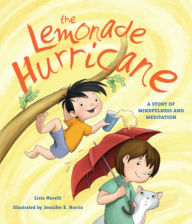5 Important Lessons from The Lemonade Hurricane

Kids these days…they never slow down! Wouldn’t it be great if there were a picture book out there that showed little ones how to put on the brakes, take a few deep breaths, and learn how to get centered? Well, good news! The Lemonade Hurricane: A Story of Mindfulness and Meditation delivers just that, through clear and child-friendly instructional text and irresistible illustrations. It’s a must-read introduction to the importance of both being, and being still. Here are five indispensable lessons it teaches.
The lesson of balance
The first things parents and kids will notice—and relate to—in The Lemonade Hurricane are all the delightful illustrations that show exactly HOW MUCH today’s children do. Big sister Emma, and her rowdy little brother Henry, are depicted engaging in all sorts of activities, from violin, karate, and soccer to getting dressed, riding scooters, and going to school. This is a masterful way to begin a children’s book on meditation. An active life, seen in full color on the page, proves how busy our modern lives have become and how much we all need a way to unwind, recharge, and find balance.
The lesson of peers
Readers soon learn through serene pictures and text that Emma is already enrolled in kids’ meditation classes as a way to manage her hectic life. Because of this, Emma desperately wishes her wild younger sibling had a way to calm down. So, she shows Henry how to sit, and bow, and breathe, and begin the journey of being still. In this way, the book is accessible to young readers. There’s no grownup in this book insisting kids “be quiet!” It’s just one child helping another find a path to peace.
The Lemonade Hurricane: A Story of Mindfulness and Meditation
The Lemonade Hurricane: A Story of Mindfulness and Meditation
By
Licia Morelli
Illustrator
Jennifer E. Morris
In Stock Online
Hardcover $17.95
The lesson of imagination
Meditation can be hard enough for adults. How do we stop thinking? How do we keep from fidgeting? Are we doing it right? Refreshingly, this book helps kids better understand meditation through imagery and imagination. Emma tells Henry to pretend he is high on a mountain looking out over the land, or that he is the breeze blowing through the trees, or that he’s riding an elephant slowly. These methods not only bring the concept of sitting alive to kids (and adults), but also provide an imaginative framework for attempting it.
The lesson of mindfulness
In addition to Emma’s gentle instruction for Henry, in the back of the book the author provides more how-to, kid-friendly tips on giving tranquility a try, such as: “How to Bow,” “How to Meditate While Lying Down,” and “How to Practice Mindfulness and Meditation.” Fun facts about zafu cushions, focusing on an object like a marble or seashell, or how many thoughts humans have in a day (70,000!), make mindfulness not just seem more understandable and necessary, but something even the youngest child can achieve.
The lesson of lemonade
At the story’s end, the author includes a wonderful anecdote about Buddhist monk Thicht Naht Hanh and how he and a young student watch the pulp sink to the bottom of a glass of apple juice. Thicht Naht Hahn explains “that the glass had been practicing sitting meditation, and by keeping still had become clear.” The author says the same holds true for lemonade. When we’re stirred up, we’re like a hurricane inside, but meditation can help calm our inner storms. It’s a terrific analogy that kids can comprehend and, with a little practice, put into play.
Would your kids enjoy a lesson mindfulness and meditation?
The lesson of imagination
Meditation can be hard enough for adults. How do we stop thinking? How do we keep from fidgeting? Are we doing it right? Refreshingly, this book helps kids better understand meditation through imagery and imagination. Emma tells Henry to pretend he is high on a mountain looking out over the land, or that he is the breeze blowing through the trees, or that he’s riding an elephant slowly. These methods not only bring the concept of sitting alive to kids (and adults), but also provide an imaginative framework for attempting it.
The lesson of mindfulness
In addition to Emma’s gentle instruction for Henry, in the back of the book the author provides more how-to, kid-friendly tips on giving tranquility a try, such as: “How to Bow,” “How to Meditate While Lying Down,” and “How to Practice Mindfulness and Meditation.” Fun facts about zafu cushions, focusing on an object like a marble or seashell, or how many thoughts humans have in a day (70,000!), make mindfulness not just seem more understandable and necessary, but something even the youngest child can achieve.
The lesson of lemonade
At the story’s end, the author includes a wonderful anecdote about Buddhist monk Thicht Naht Hanh and how he and a young student watch the pulp sink to the bottom of a glass of apple juice. Thicht Naht Hahn explains “that the glass had been practicing sitting meditation, and by keeping still had become clear.” The author says the same holds true for lemonade. When we’re stirred up, we’re like a hurricane inside, but meditation can help calm our inner storms. It’s a terrific analogy that kids can comprehend and, with a little practice, put into play.
Would your kids enjoy a lesson mindfulness and meditation?
